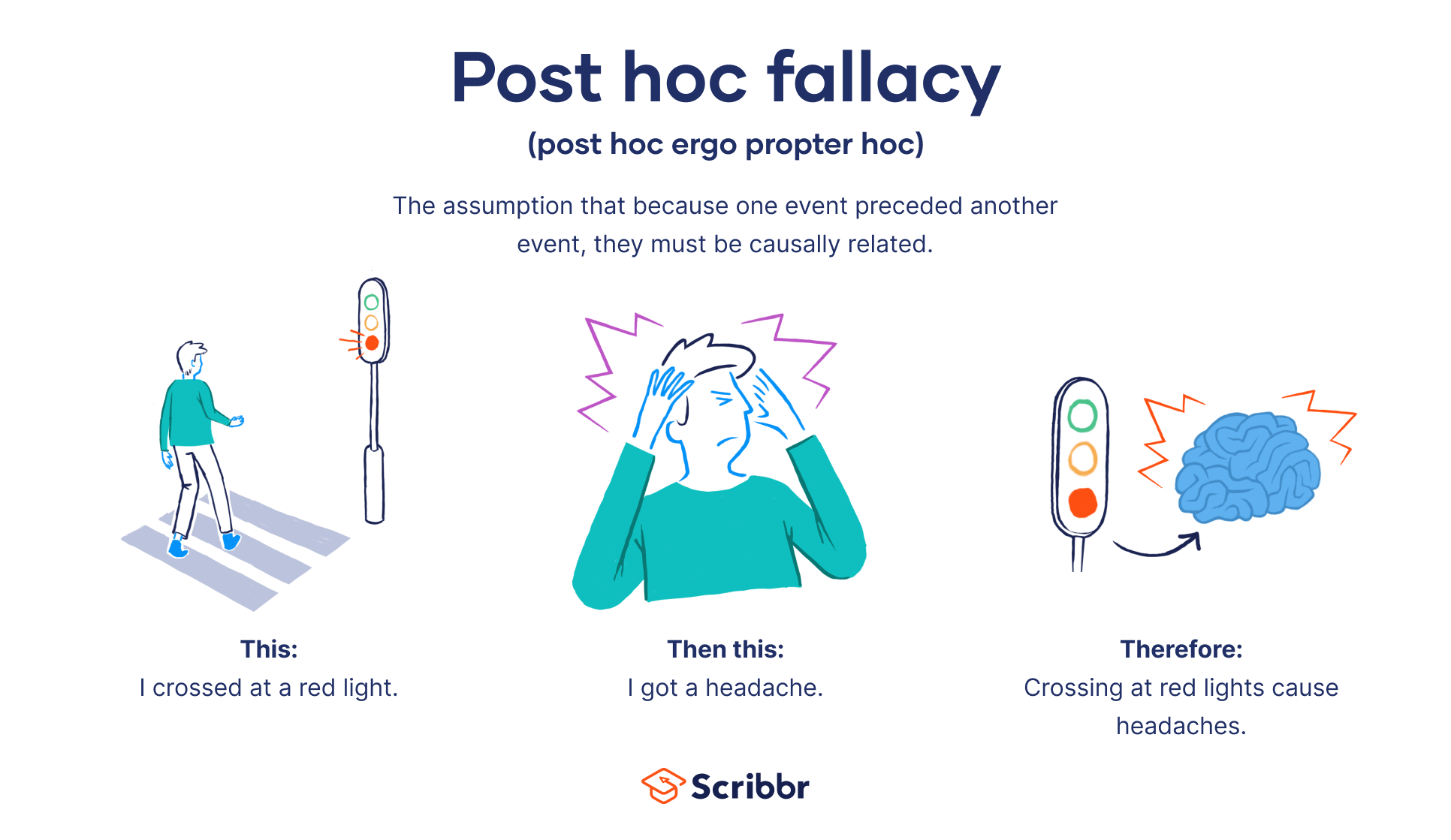Post Hoc Fallacy | Definition & Examples
The post hoc fallacy is the assumption that because one event preceded another event, they must be causally related. In other words, the first event must have caused the second.
However, the chronological order of two events does not prove a cause-and-effect relationship between them.
Making erroneous assumptions about the cause of events can lead us to wrong decisions in many important areas of everyday life, including economics, policy, and health. The post hoc fallacy is also known as the fallacy of false cause, questionable cause, and faulty causation.
What is post hoc fallacy?
The post hoc fallacy occurs when we draw a causal conclusion without sufficient evidence to support it. “Post hoc” is a shortened version of the Latin phrase “post hoc ergo propter hoc”, meaning “after this, therefore because of this”.
Post hoc fallacies are committed when one argues that because B happened immediately after A, A must be the cause of B. The point is not that there can’t be a causal connection between A and B but rather that there isn’t adequate evidence for the conclusion.
In the example above, even if the software did cause the computer to crash, there isn’t enough evidence to prove this: the chronological order of the events alone does not justify the causal conclusion.
The post hoc fallacy is a form of logical fallacy because it is based on a false premise: the idea that if one event happens before another, then the first event must be the cause of the second.
More specifically, it belongs to the category of causal fallacies, where a causal connection is assumed without proof, merely on the basis of correlation or co-occurrence. In research, the same idea is expressed through the phrase “correlation doesn’t imply causation”.
Why is post hoc fallacy a problem?
The post hoc fallacy leads to misconceptions about the causes of various phenomena. It is at the heart of many pseudoscientific arguments, the most notable and persistent being the false belief that certain types of vaccines are responsible for autism in children.
The post hoc fallacy can also lead to magical thinking: the belief that unrelated events are causally connected despite the absence of any plausible link (e.g., believing that inner thoughts can influence the external world without action). Superstitions (e.g., attributing a misfortune to an “unlucky” event like walking under a ladder) follow the same pattern.
Sometimes, people make a logical leap to post hoc thinking when they believe that they can eliminate a problem by eliminating its (alleged) cause.
This often plays out in how politicians interpret unemployment statistics or crime reduction. In this case, post hoc fallacy (A caused B) is combined with denying the antecedent, another fallacy which takes it a step further by assuming that “if A caused B, avoiding A will prevent B”.
Why does post hoc fallacy occur?
People often commit the post hoc fallacy without realising it, simply because of the way the human mind has evolved: it extracts causality from coincidences. Due to this, people confuse the temporal order of events with an actual causal connection. Chronological order is a necessary but not sufficient condition of a cause-and-effect relationship.
A number of cognitive biases may also feed into people’s tendency to fall for the post hoc fallacy. For example, jumping-to-conclusions bias (making decisions without enough information) can misguide people into inferring causality.
Similarly, confirmation bias can lead people to search for or interpret information in a way that confirms their preexisting belief that a cause-and-effect relationship exists.
Post hoc fallacy examples
Sports fans also commit post hoc fallacy when they believe that following certain patterns of behaviour will somehow influence the outcome of a game.
Despite knowing that a causal relationship between your behaviour and the outcome of the game is impossible, you can’t help but feel responsible. For the next game, you decide to stay put and avoid going to the kitchen.
The tendency to look for causal relationships is so strong that people infer them even when they are rationally convinced that the causal mechanism needed to make such a relationship plausible does not exist.
In research, post hoc fallacy occurs when researchers do not carefully consider the relationship between variables.
The media picks up the research results and circulates them widely with headlines like “Taking a Bath Is Good for Your Heart”.
However, without a controlled experiment where participants are randomly assigned to a control or treatment group, it’s hard to know whether this relationship is causal. For example, an alternative explanation could be that those who take baths regularly have more time at their disposal and are generally less stressed.
Claiming that baths are the reason for lower rates of heart disease among regular bath takers is a form of post hoc fallacy.
Other interesting articles
If you want to know more about fallacies, research bias, or AI tools, make sure to check out some of our other articles with explanations and examples.
AI tools
Fallacies
Frequently asked questions about post hoc fallacy
Cite this Scribbr article
If you want to cite this source, you can copy and paste the citation or click the ‘Cite this Scribbr article’ button to automatically add the citation to our free Reference Generator.
Nikolopoulou, K. (2023, November 27). Post Hoc Fallacy | Definition & Examples. Scribbr. Retrieved 15 December 2025, from https://www.scribbr.co.uk/fallacy/the-post-hoc-fallacy/




